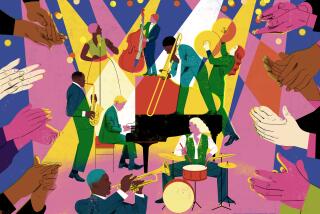Jazz Reviews : Good Vibes From Burton at El Camino
- Share via
Gary Burton, long recognized as the foremost vibist in jazz, brought his quintet to El Camino College’s Marsee Auditorium on a rare visit to the Southland.
In the course of his two-hour concert, he offered ample evidence of his style, defined by exemplary technique and total musicality. Too bad then, that the 2,000-seat auditorium was barely a quarter filled.
One would be hard pressed to find a musician more lyrical than Burton. Whether exploring the rhythmic complexities of Makoto Ozone’s “Cato’s Revenge,” the intricate harmonies of Chick Corea’s “P.M.” or the infinite melodic variations of “On the Street Where You Live,” Burton seemed the calm eye at the center of a storm.
Burton fronted a quintet of youngsters (“They seem to get younger and younger,” he quipped) whom he scouted at Boston’s Berklee College of Music, where the vibist once studied and where he currently teaches. Each was a capable player who displayed jazz sensibilities beyond his years.
Pianist Ozone, who has worked with Burton for the last six years and who was the major contributor of compositions to the two-set concert Sunday evening, showed himself to be a player as comfortable with the pair of standards the group offered as he was with his own pieces. He was especially effective on “I Need You Here,” a lovely ballad he constructed from a pair of complementing countermelodies.
Though Burton has more often than not featured a guitarist as his foil, he currently features tenor saxophonist Donny McCaslin. A player of strength and imagination, he also supplied a jagged, angular contrast to Burton’s more mellifluous style.
Playing solid support roles were drummer Martin Richards and bassist Gildas Bocle, the latter soloing only briefly, but quite effectively on the Victor Young classic “Beautiful Love.”
A longtime champion of the avant garde, Burton’s devotion to melody and beautiful texture has made his music far more palatable to the average listener. He also seemed to have more fun creating his art. His inclusion of standards, ballads and a Western-swing styled “Soulful Bill” also showed that great, contemporary music is not limited by structure or source.
More to Read
The biggest entertainment stories
Get our big stories about Hollywood, film, television, music, arts, culture and more right in your inbox as soon as they publish.
You may occasionally receive promotional content from the Los Angeles Times.








